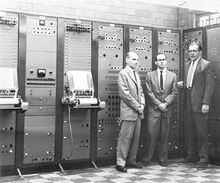
The RCA Synthesizer Mark II at Columbia. Pictured are, from left to right: Milton Babbitt, Peter Mauzey, and Vladimir Ussachevsky.
A pioneering electronic music instrument, created by the RCA corporation in the 1950s. There were actually two units built. The original one was built and installed at RCA's Sarnoff Research Center in Princeton, New Jersey USA in 1955. Several prominent avant-garde musicians of the day contributed conceptual ideas to the design, including Vladimir Ussachevsky, but the actual electrical engineering was executed by RCA engineers Herbert Belar and Harry Olson. This was a two-voice polyphonic system, using multiple frequency sources with octave divider circuits to produce the notes of the musical scale. To modify the timbre, it had high pass and low pass filters for each voice, as well as resonators, fixed filters, and reverberation devices that could be patched in. The circuitry was executed entirely with vacuum tubes and took up most of a large room.
Control of the instrument was through an unconventional means. Tracks to be played were prepared offline, using a mechanical keyboard that prepared a punched paper tape. The composer could -- in fact, had to -- specify timing, frequency, harmonic, envelope, timbre, and modulation parameters for every single note. The completed tape was then run through the machine, which executed the performance. Correcting mistakes involved punching a new section of tape and splicing it in. All signal routing was done with patch cords, in the style of a modular synthesizer, although that concept was unknown at the time. The synthesizer had its own means to record the audio from performances; originally this was an acetate cutting lathe, later replaced by a tape recorder.
RCA built and installed an improved version, the Mark II, at the Columbia University's Computer Music Center (then known as the Columbia-Princeton Electronic Music Center) in 1957. This unit was four-voice polyphonic and had some additional modulation capabilities. It attracted the interest of several modern classical composers; in particular, the machine's capabilities and the way it forced the composer to work were a perfect match for the serialism movement of that era. Among the composers who used the machine frequently were Milton Babbitt and Charles Wuorinen, the latter of whom composed the Pulitzer Prize-winning "Time's Encomium" on it in 1968.
Unforunately neither machine survives in good condition today. The Mark I apparently was dismantled some time after 1960 (parts from it may have been used to repair the Mark II). The Mark II is still at Columbia, but has not been maintained and reportely is in poor condition. It was vandalized sometime in the early 1970s and saw little use after that.